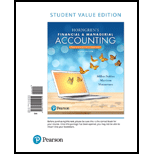
Concept explainers
Disposal of Assets: Disposal is an activity of selling the worn-out assets that is no longer in need for the business, in return of some consideration. Disposal may be made in any of the following situations:
- Disposal with no gain no loss: When the asset is disposed with no consideration received.
- Disposal with gain: When the asset is disposed for more than its book value (original cost less
accumulated depreciation ). - Disposal with loss: When the asset is disposed for less than its book value.
Straight-line Depreciation: Under the straight-line method of depreciation, the same amount of depreciation is allocated every year over the estimated useful life of an asset. The formula to calculate the depreciation cost of the asset using the salvage value is shown as below:
To journalize: the sale of the equipment under the straight-line method.
Want to see the full answer?
Check out a sample textbook solution
Chapter 9 Solutions
Horngren's Financial & Managerial Accounting, The Financial Chapters, Student Value Edition (6th Edition)
- SUBJECT FINANCIAL ACCOUNTINGarrow_forward??arrow_forwardEric Church Company is a price-taker and uses a target- pricing approach. Refer to the following information: Production volume 920,000 units per year Market price $33 per unit Desired operating income 17% of total assets Total assets $12,630,000 What is the desired profit for the year?arrow_forward

 AccountingAccountingISBN:9781337272094Author:WARREN, Carl S., Reeve, James M., Duchac, Jonathan E.Publisher:Cengage Learning,
AccountingAccountingISBN:9781337272094Author:WARREN, Carl S., Reeve, James M., Duchac, Jonathan E.Publisher:Cengage Learning, Accounting Information SystemsAccountingISBN:9781337619202Author:Hall, James A.Publisher:Cengage Learning,
Accounting Information SystemsAccountingISBN:9781337619202Author:Hall, James A.Publisher:Cengage Learning, Horngren's Cost Accounting: A Managerial Emphasis...AccountingISBN:9780134475585Author:Srikant M. Datar, Madhav V. RajanPublisher:PEARSON
Horngren's Cost Accounting: A Managerial Emphasis...AccountingISBN:9780134475585Author:Srikant M. Datar, Madhav V. RajanPublisher:PEARSON Intermediate AccountingAccountingISBN:9781259722660Author:J. David Spiceland, Mark W. Nelson, Wayne M ThomasPublisher:McGraw-Hill Education
Intermediate AccountingAccountingISBN:9781259722660Author:J. David Spiceland, Mark W. Nelson, Wayne M ThomasPublisher:McGraw-Hill Education Financial and Managerial AccountingAccountingISBN:9781259726705Author:John J Wild, Ken W. Shaw, Barbara Chiappetta Fundamental Accounting PrinciplesPublisher:McGraw-Hill Education
Financial and Managerial AccountingAccountingISBN:9781259726705Author:John J Wild, Ken W. Shaw, Barbara Chiappetta Fundamental Accounting PrinciplesPublisher:McGraw-Hill Education





